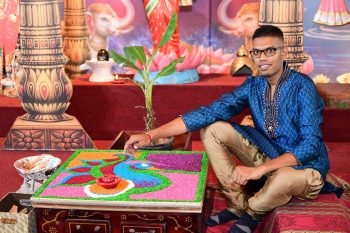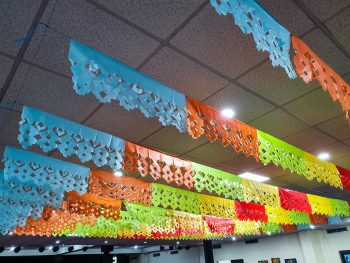As we commemorate 178 years of Indian presence in Trinidad and Tobago, I felt obligated as an artist to posit insights into two areas of Indian Folk Art which have been brought from India to the Caribbean, and still prevail despite divergent influences. In this blog I feature the art of Rangoli and Kite Paper Cutting. Through a local (Trinbagonian) lens, there has not been much enquiry and written documentation on this particular subject matter. I saw this as an opportunity to allow the narrative to fill a lacuna as well as to produce archival material for posterity.
RANGOLI

Rangoli executed on a bedi at the Divali Nagar by Richard Rampersad. May 2022.
Rangoli is derived from the Sanskrit word ‘rangavalli’, which means colour.
It is a traditional art form originating in ancient India, and its primary purpose is to honour, celebrate, cleanse and mark various occasions. When sacred spaces need to be created, cleared and cleaned for ritual purposes, rangoli is drawn with coloured rice or powder, flower petals, chalk or paint in a range of geometric designs, patterns or symbols.
The practice was brought to the Caribbean by indentured Indians; however, it was mainly limited to designs using flour on a bedi (altar made of dirt and smeared with gobar [cow dung]) being prepared for puja (prayers). The designs include interlocking line-work and geometric configurations of shapes.
These days, as a result of Bollywood influences and globalization, Rangoli takes the form of bright colourful ornate designs such as peacocks, elephants, floral emblems and even deities usually decorating the entrance to a temple, wedding or religious celebration. It invokes beauty and wonder and has become a visual map for auspiciousness and ritual engagement.

Peacock inspired Rangoli, November 2022 Photo by Devon Parker
KITE-PAPER CEILING ART
This style of Kite Paper art is a practice brought by the girmitiyas or indentured labourers. The process involves cutting out patterns or shapes within the kite paper, so that when it is spread on a string, via flour and water, it takes the form of a beautiful hanging or ceiling decoration, with many shapes and designs interspersed throughout.

Kite Paper Art by Kajal Madoo, NCIC 2022. Photo by Richard Rampersad.
A stencil is created from bristol board, from which many patterns can be replicated. It is then traced onto the stacked sheets of kite paper and cut with a paper chisel or scissors.
The shapes are usually geometric configurations, religious symbols or silhouettes of various deities and other anthropomorphic forms. Several years ago, it was common during yagnas (nightly prayer services) held in constructed sheds or in people’s homes, to see this craft displayed in different colours. It was a communal endeavour for friends, family and neighbours to come together and meticulously draw, fold and cut the layers of stacked paper for hours. The practice is still continued today, though it is not as prominent as before.
Store bought Toorans/ Malas (floral garlands) and fabric have replaced these suspended kite paper art as they are more time efficient to install, as well as being the trend in popular culture.

Kite Paper by Kajal Madoo, NCIC 2022. Photo by Richard Rampersad.
Sources:
Rampersad, R. (2018). Memories in Mud: Probing the Material Culture of the Pottery Tradition in Central Trinidad. Unpublished MA Thesis, University of the West Indies.
About the Author
Richard Rampersad is a Visual Artist, Educator and Curator based in Trinidad and Tobago. His research interests are in the areas of Material Culture, Visual Culture and the East Indian Experience in the Caribbean. Rampersad holds a BA in Visual Arts and an M.A in Cultural Studies from the University of the West Indies (UWI) St. Augustine Campus.


